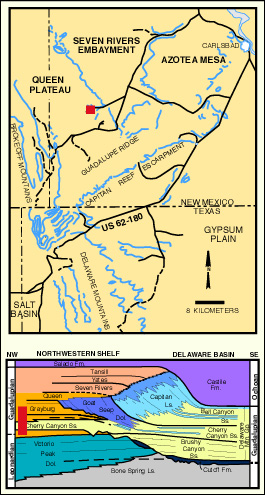
Permian Reef Complex Virtual Field Trip
Stop III-7: Last Chance Canyon

Cliff on north side of Last Chance Canyon (on right) has exposures of lower San Andres Ls. (at very base) overlain by the thick sandstone tongue of the Cherry Canyon Fm.; the upper San Andres carbonate and Grayburg Fm. sandstones and carbonates form the top of the section. A major angular discordance is visible between the downlapping beds of the Cherry Canyon sandstone tongue and the lower San Andres Fm. A thin, recessive, condensed, black shale section can be seen on the downlap surface just above the lower San Andres carbonates. A more subtle discordance is also present between the upper San Andres and the Grayburg Fm., marked by a prominent but thin white sandstone ledge (equivalent to the Premier Sandstone in the subsurface). Also note probable replaced evaporite nodules in these slope to base of slope sands good evidence for refluxing of shelf-derived brines.
Excellent, if extensively dolomitized, exposures of the lower San Andres Fm., as well as outstanding debris flows of the Cutoff Shale, can be examined by walking up Last Chance Canyon for a few hundred meters. Recent field descriptions based on seismic and sequence stratigraphic studies (Sarg, 1986; Sarg and Lehmann, 1986a; Sarg and Lehmann, 1986b; Wilkinson et al., 1991; Gardner, 1991; Sonnenfeld, 1991 and 1993; Sonnenfeld and Cross, 1993; Adams, 1993) are especially useful for those who wish to explore these outcrops more fully. A walk up-canyon to view the outcrops of Lower San Andres and/or Cutoff Fm. slope facies carbonates is well worth the effort of battling through the thorn brush. Superb exposures of the scoured bases and hummocky tops of multiple debris flows with onlapping slope sediments are to be found there (see photo).

© Peter A. Scholle, 1999
Mescalero Apache petroglyphs (and more recent markings) can be seen on the Cherry Canyon Sandstone Tongue cliffs. The Mescalero Apaches (from the Zuni word "Apachu" meaning "enemy") are believed to have entered this area from the north in about 1300 AD. These hunter-gatherers built wooden lean-tos or lived in caves and rock overhangs like this one.
Return to Dark Canyon-Sitting Bull Falls-Rocky Arroyo Roadlog


